This article needs additional citations for verification .(January 2017) |
Futura, Croatian journal of speculative fiction, was a science fiction magazine. It was in circulation between 1992 and 2010.
This article needs additional citations for verification .(January 2017) |
Futura, Croatian journal of speculative fiction, was a science fiction magazine. It was in circulation between 1992 and 2010.
Futura was first published in October 1992. [1] The magazine was started by Bakal doo, a graphic design and publishing company from Zagreb, as the unofficial successor of Sirius, which was published from April 1976 to December 1989. [1] Initially published only by the authors, but with the arrival of a new editor, Krsto A. Mažuranić, editorial policy is changed. In almost every issue one or two stories of local authors appeared, which contributed to the development of a new generation of Croatian SF writers mid-90s, among which the most significant ones were Marina Jadrejčić, Tatjana Jambrišak, Darko Macan and Aleksandar Žiljak.
During 2000 and 2001, Futura ceased to hold mainly regular monthly publication rhythm, and starting with the number 94, in the July 2001 the company Strip-Agent Ltd. from Zagreb overtook issuing of Futura. The magazine was published regularly until 2004, but in 2005 only six numbers were published. In 2006 only three issues were published, and in 2007 only one issue appeared. Futura was suspended with the December 2010 issue (#131). [1]
Editors:
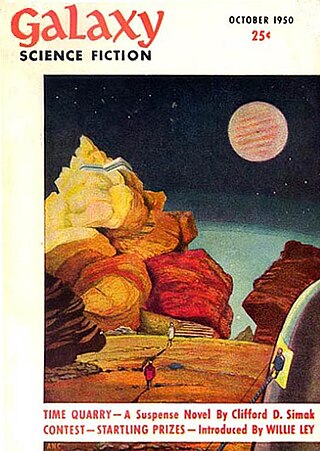
Galaxy Science Fiction was an American digest-size science fiction magazine, published in Boston from 1950 to 1980. It was founded by a French-Italian company, World Editions, which was looking to break into the American market. World Editions hired as editor H. L. Gold, who rapidly made Galaxy the leading science fiction magazine of its time, focusing on stories about social issues rather than technology.

Asimov's Science Fiction is an American science fiction magazine edited by Sheila Williams and published by Dell Magazines, which is owned by Penny Press. It was launched as a quarterly by Davis Publications in 1977, after obtaining Isaac Asimov's consent for the use of his name. It was originally titled Isaac Asimov's Science Fiction Magazine, and was quickly successful, reaching a circulation of over 100,000 within a year, and switching to monthly publication within a couple of years. George H. Scithers, the first editor, published many new writers who went on to be successful in the genre. Scithers favored traditional stories without sex or obscenity; along with frequent humorous stories, this gave Asimov's a reputation for printing juvenile fiction, despite its success. Asimov was not part of the editorial team, but wrote editorials for the magazine.

The Magazine of Fantasy & Science Fiction is a U.S. fantasy and science fiction magazine, first published in 1949 by Mystery House, a subsidiary of Lawrence Spivak's Mercury Press. Editors Anthony Boucher and J. Francis McComas had approached Spivak in the mid-1940s about creating a fantasy companion to Spivak's existing mystery title, Ellery Queen's Mystery Magazine. The first issue was titled The Magazine of Fantasy, but the decision was quickly made to include science fiction as well as fantasy, and the title was changed correspondingly with the second issue. F&SF was quite different in presentation from the existing science fiction magazines of the day, most of which were in pulp format: it had no interior illustrations, no letter column, and text in a single-column format, which in the opinion of science fiction historian Mike Ashley "set F&SF apart, giving it the air and authority of a superior magazine".
Croatian science fiction comprises books and films in the fiction genre produced all across Croatia.

Aleksandar Žiljak is a science fiction and fantasy writer and illustrator from Zagreb, Croatia. In 2006, he co-edited Ad Astra, an anthology of Croatian SF stories, which covers period from 1976 to 2006, and he co-edits Croatian literary SF journal Ubiq.
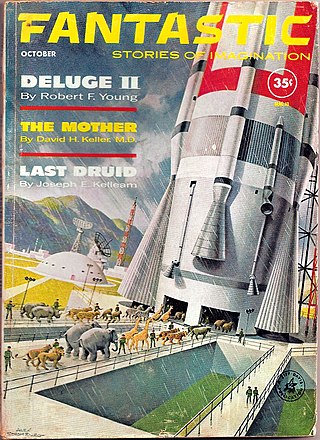
Fantastic was an American digest-size fantasy and science fiction magazine, published from 1952 to 1980. It was founded by the publishing company Ziff Davis as a fantasy companion to Amazing Stories. Early sales were good, and the company quickly decided to switch Amazing from pulp format to digest, and to cease publication of their other science fiction pulp, Fantastic Adventures. Within a few years sales fell, and Howard Browne, the editor, was forced to switch the focus to science fiction rather than fantasy. Browne lost interest in the magazine as a result and the magazine generally ran poor-quality fiction in the mid-1950s, under Browne and his successor, Paul W. Fairman.

Dušan Vukotić was a Yugoslav and Croatian-Montenegrin cartoonist, author and director of animated films. He is the best known member of the Zagreb school of animated films.

A science fiction magazine is a publication that offers primarily science fiction, either in a hard-copy periodical format or on the Internet. Science fiction magazines traditionally featured speculative fiction in short story, novelette, novella or novel form, a format that continues into the present day. Many also contain editorials, book reviews or articles, and some also include stories in the fantasy and horror genres.
Darko Ronald Suvin is a Canadian academic, writer and critic who became a professor at McGill University in Montreal. He was born in Zagreb, which at the time was in Kingdom of Yugoslavia, now the capital of Croatia. After teaching at the Department for Comparative Literature at the Zagreb University, and writing his first books and poems in his native language, he left Yugoslavia in 1967, and started teaching at McGill University in 1968.
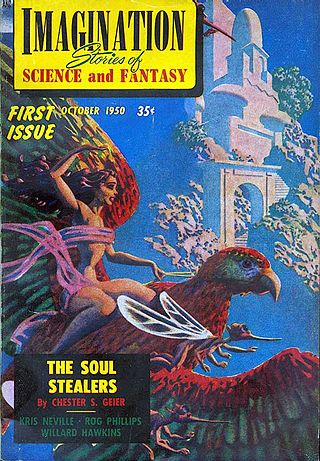
Imagination was an American fantasy and science fiction magazine first published in October 1950 by Raymond Palmer's Clark Publishing Company. The magazine was sold almost immediately to Greenleaf Publishing Company, owned by William Hamling, who published and edited it from the third issue, February 1951, for the rest of the magazine's life. Hamling launched a sister magazine, Imaginative Tales, in 1954; both ceased publication at the end of 1958 in the aftermath of major changes in US magazine distribution due to the liquidation of American News Company.

Matica hrvatska is the oldest independent, non-profit and non-governmental Croatian national institution. It was founded on February 2, 1842 by the Croatian Count Janko Drašković and other prominent members of the Illyrian movement during the Croatian National Revival (1835–1874). Its main goals are to promote Croatian national and cultural identity in the fields of art, science, spiritual creativity, economy and public life as well as to care for social development of Croatia.
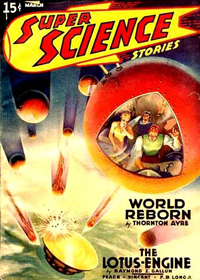
Super Science Stories was an American pulp science fiction magazine published by Popular Publications from 1940 to 1943, and again from 1949 to 1951. Popular launched it under their Fictioneers imprint, which they used for magazines, paying writers less than one cent per word. Frederik Pohl was hired in late 1939, at 19 years old, to edit the magazine; he also edited Astonishing Stories, a companion science fiction publication. Pohl left in mid-1941 and Super Science Stories was given to Alden H. Norton to edit; a few months later Norton rehired Pohl as an assistant. Popular gave Pohl a very low budget, so most manuscripts submitted to Super Science Stories had already been rejected by the higher-paying magazines. This made it difficult to acquire good fiction, but Pohl was able to acquire stories for the early issues from the Futurians, a group of young science fiction fans and aspiring writers.
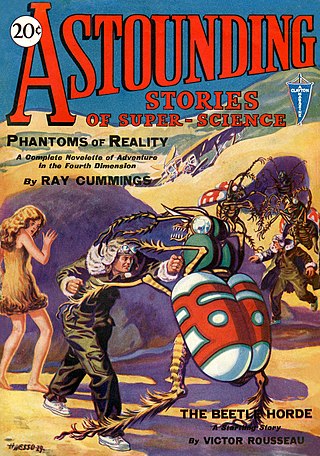
Analog Science Fiction and Fact is an American science fiction magazine published under various titles since 1930. Originally titled Astounding Stories of Super-Science, the first issue was dated January 1930, published by William Clayton, and edited by Harry Bates. Clayton went bankrupt in 1933 and the magazine was sold to Street & Smith. The new editor was F. Orlin Tremaine, who soon made Astounding the leading magazine in the nascent pulp science fiction field, publishing well-regarded stories such as Jack Williamson's Legion of Space and John W. Campbell's "Twilight". At the end of 1937, Campbell took over editorial duties under Tremaine's supervision, and the following year Tremaine was let go, giving Campbell more independence. Over the next few years Campbell published many stories that became classics in the field, including Isaac Asimov's Foundation series, A. E. van Vogt's Slan, and several novels and stories by Robert A. Heinlein. The period beginning with Campbell's editorship is often referred to as the Golden Age of Science Fiction.
SFera is a science fiction society from Zagreb, Croatia. It was founded in 1976, thus marking the beginnings of organised science fiction fandom in the region.

Milan Moguš was a Croatian linguist and academician.

Vargo Statten Science Fiction Magazine was a British science fiction magazine which published nineteen issues between 1954 and 1956. It was initially published by Scion Press, with control passing to a successor company, Scion Distributors, after Scion went bankrupt in early 1954. At the end of 1954, as part payment for a debt, Scion Distributors handed control of the magazine to Dragon Press, who continued it for another twelve issues. E. C. Tubb and John Russell Fearn were regular contributors, and Kenneth Bulmer also published several stories in the magazine. Barrington Bayley's first published story, "Combat's End", appeared in May 1954. The editor was initially Alistair Paterson, but after seven issues Fearn took the helm: "Vargo Statten" was one of Fearn's aliases, and the magazine's title had been chosen because of his popularity. Neither Paterson nor Fearn had enough of a budget to attract good quality submissions, and a printing strike in 1956 brought an end to the magazine's life.
The SFera Award is awarded annually by the science fiction society SFera in Zagreb since 1981. Until 1991, it was given to participants from whole of Yugoslavia, but since 1994 only for works originally published in Croatian.
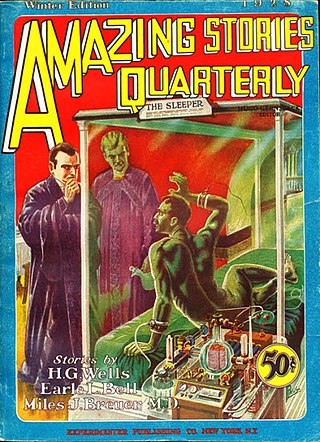
Amazing Stories Quarterly was a U.S. science fiction pulp magazine that was published between 1928 and 1934. It was launched by Hugo Gernsback as a companion to his Amazing Stories, the first science fiction magazine, which had begun publishing in April 1926. Amazing Stories had been successful enough for Gernsback to try a single issue of an Amazing Stories Annual in 1927, which had sold well, and he decided to follow it up with a quarterly magazine. The first issue of Amazing Stories Quarterly was dated Winter 1928 and carried a reprint of the 1899 version of H.G. Wells' When the Sleeper Wakes. Gernsback's policy of running a novel in each issue was popular with his readership, though the choice of Wells' novel was less so. Over the next five issues, only one more reprint appeared: Gernsback's own novel Ralph 124C 41+, in the Winter 1929 issue. Gernsback went bankrupt in early 1929, and lost control of both Amazing Stories and Amazing Stories Quarterly; associate editor T. O'Conor Sloane then took over as editor. The magazine began to run into financial difficulties in 1932, and the schedule became irregular; the last issue was dated Fall 1934.
Yugoslav science fiction comprises literary works, films, comic books and other works of art in the science fiction genre created in Yugoslavia during its existence (1918–1991).
Sirius was a Croatian science fiction magazine from Zagreb, SR Croatia, Yugoslavia. It was named after the brightest star in the sky, seen from Earth. It was published by the Zagreb newspaper and publishing house Vjesnik from 1976 to 1989. The magazine stopped circulating in 1990.